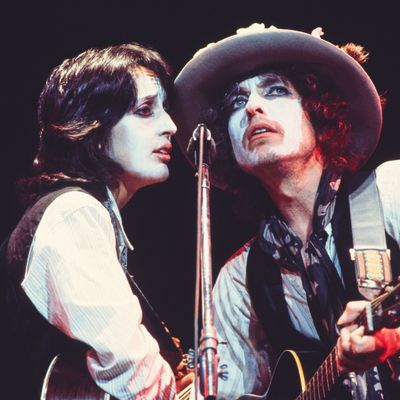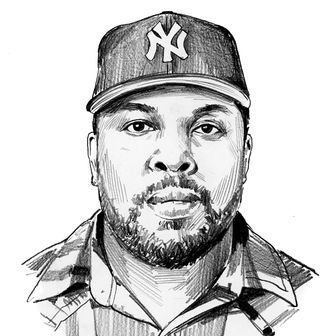
Memories fade in time, like fabric. What’s left is a flash, a feeling, the intoxicating rhythm of a crush’s speech pattern, the scent of the failing air freshener in an old friend’s car, the lights and smoke playing off each other in a wild night out. Asked what memory lingers from the raucous 1975 folk tour documented in Netflix’s new Rolling Thunder Revue: A Bob Dylan Story, by Martin Scorsese, Dylan can’t come up with one. The trek didn’t make much money. Renaldo and Clara — the patchy four-hour silver-screen fever dream he made out of the footage in the late ’70s — was panned. To him, the tour’s legacy is, in a word, “Ashes.” He’s joking. Oscar-winning directors don’t make two-and-a-half-hour films about shit tours. Rolling Thunder captured a moment when Bob Dylan got back to the business of being Bob Dylan.
Dylan got spooked at the end of the ’60s, anointed as a hero and poked and prodded for details about his life and history when what he appeared to want was, to quote the man himself, to be “a complete unknown.” You could see him jostling with the fame machine in documentarian D.A.
Pennebaker’s Dont Look Back, which caught the singer on tour in 1965 reacting to a whirlwind of public interest by engaging fans and interviewers in wry, satirical sparring matches. Dylan famously quit touring in 1966 and receded into the quiet of his Woodstock, New York, home after a motorcycle accident, reemerging for a while as a country singer and ditching the legendary music-and-arts spectacle named for his own town in 1969 for the U.K.’s Isle of Wight festival. 1970’s confrontationally hollow double album Self Portrait punctuated the point the Woodstock no-show tried to drive home: Good luck seeking that which does not wish to be found.
We’re out of this fog when Rolling Thunder Revue begins. Our hero is spiriting through rooms full of New York kooks having a blast watching an order of local hustlers, squares, geniuses, and onlookers angle for his time and attention. He meets Patti Smith and decides he wants to assemble a band from the ground up like hers, and the seed for our story is planted. (Smith is magnetic early on in a free-associative coffee-house rant that turns into an embryonic rendition of what later became Radio Ethiopia’s “Ain’t It Strange.”) Dylan assembles a ragtag band featuring Ronnie Hawkins (whose backup players famously became the Band), Ronee Blakely (fresh off the lead in Robert Altman’s Nashville), and session players including the mysterious violinist Scarlet Rivera. They cut the songs from the 1976 classic Desire and set out on a tour to play small markets at lower prices than Dylan and the Band’s 1974 arena tour could cover.
The tour blew through New York, Connecticut, and Massachusetts like drifts in a nor’easter, snowballing in size as time went on. By the end, the cast of players included poet Allen Ginsberg, Bowie guitarist Mick Ronson, singer-songwriters Joan Baez and Joni Mitchell, Byrds front man Roger McGuinn, folk legend Ramblin’ Jack Elliott, screenwriter Sam Shepard, Rolling Stone writer Larry “Ratso” Sloman, and whoever else managed to worm their way into accommodations. Martin Scorsese’s doc nails the impossible trick of seeming as light, freewheeling, and indescribable as its subject matter. It approaches its legend as tellers of tall tales do. In interviews after the fact, the survivors all remember it differently. Bob, at once pop’s greatest obfuscator and its single most documented subject (short of the Grateful Dead), is clearly here to fuck with us, as is our director. As our subjects’ recollections grow foggy, so does the film’s narrative.
Some of this shit never happened, and it’s tricky to tell what’s what. European filmmaker Stefan van Dorp, said in the film to have been the fly on the wall who recorded the original tour footage, is really a character played by Bette Midler’s husband, Martin von Haselberg, who actually showed up to the film’s Lincoln Center premiere and spoke as the character. Scorsese blurs your sense of time with archival footage of events from different years than the one you’re meant to be revisiting. The Congressman Jack Tanner, who claims in the film that Jimmy Carter personally called Dylan to get him into a show, is clearly the Jack Tanner from Robert Altman’s HBO political satire Tanner ’88, reprised, per the credits, by actor Michael Murphy.
In time, the anachronisms and exaggerations have the effect of making the tour’s real-life far-fetched moments seem all the more mythical. Combing the Rolling Thunder Revue companion album, which collects shows and rehearsals from the tour, you note that Dylan really did do “The Ballad of Ira Hayes,” the Peter LaFarge song about the Native American Iwo Jima hero said to have died of alcohol poisoning, at the Tuscatora Reservation near Niagara Falls and treated baffled old ladies at a Massachusetts mah-jongg parlor to a “Simple Twist of Fate.” An old news report corroborates the scene where the pro-black protest song “Hurricane” is played at Clinton Prison in New Jersey. But not everything checks out, nor does it have to.
Rolling Thunder Revue truly shines in the concert footage. The band is absolutely electric throughout searing renditions of Desire cuts like “Isis.” It brings out another side of Joan Baez, who admits to trying dance moves with the Revue that she’d never pull in her own shows. Mick Ronson is a titan. Scarlet Rivera’s playing is enticing and intuitive. Roger McGuinn is absolutely overjoyed to be singing alongside the man whose songs helped the Byrds take flight. Dylan stands in the middle of the maelstrom dripping in frills and flowers and Kabuki makeup, like some traveling antebellum era herbalist hawking healing elixirs out of a covered wagon. Singing “Hurricane” through an outraged snarl and barking every word of “A Hard Rain’s A-Gonna Fall” as though he were a prophet delivering a promise of damnation, Dylan is confronting us with the difference between the stated idea of America and the present reality of it, in the process asking why, after 200 years, we still haven’t gotten our shit together. The question stands.
Rolling Thunder Revue is a brilliant rock doc because it doesn’t take itself too seriously and because it recognizes that rock and roll is a kingdom built on borrowed threads and fudged facts. It details the experience of getting caught up in a life-changing moment and how the memory of it changes with time for everyone involved. (More importantly, the film and the live recordings rescue hours of iconic moments from the fuzzy tape transfers and spotty compilations they’ve lived on up ’til now. The footage of Dylan and Ginsberg reading poetry at Jack Kerouac’s Lowell, Massachusetts, grave is as crisp as the sharpest photos of the day. The new boxed set renders the Rolling Thunder Bootleg Series compilation and the second-leg live album Hard Rain useless through sheer breadth of detail.) The moral of Rolling Thunder Revue is that if you wanted the whole story, you ought to have been there … but if you weren’t, have a taste.


